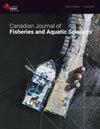Modeling Slough Crayfish Populations in Response to Hydrologic Variability
IF 1.9
2区 农林科学
Q2 FISHERIES
Canadian Journal of Fisheries and Aquatic Sciences
Pub Date : 2024-06-14
DOI:10.1139/cjfas-2024-0052
引用次数: 0
Abstract
Understanding and predicting animal population dynamics as a function of hydrologic variation is critical for the management of freshwater ecosystems. Crayfish are important fauna supported by the hydro-dynamic freshwater wetlands of the Everglades. We modeled the complex relationships between slough crayfish (Procambarus fallax) population densities and hydrologic conditions using a spatially and temporally extensive 21-year dataset. We applied linear mixed–effect models, a classification and regression tree (CART), and random forest (RF) algorithms to develop predictions and eco-hydrologic interpretations. The random forest model demonstrated the greatest predictive ability (R2 = 0.56) followed by linear mixed–effect models (R2 = 0.45) and the regression tree (R2 = 0.29). Primary effects of hydrologic terms were similar among models, but the RF model identified important nonlinear and threshold relationships. Lower average depths (appr. 30–60 cm) over the year prior to the sample, in conjunction with relatively long periods of inundation, and moderate recent depths, were associated with greater crayfish densities. The three methods revealed consistent understanding of crayfish eco-hydrologic relations and provide insight for natural resource management.模拟溪沟螯虾种群对水文变异的响应
了解和预测动物种群动态对淡水生态系统的管理至关重要。螯虾是大沼泽地水动力淡水湿地支持的重要动物。我们利用 21 年的广泛时空数据集,模拟了沼泽螯虾(Procambarus fallax)种群密度与水文条件之间的复杂关系。我们采用线性混合效应模型、分类和回归树(CART)以及随机森林(RF)算法来进行预测和生态水文解释。随机森林模型的预测能力最强(R2 = 0.56),其次是线性混合效应模型(R2 = 0.45)和回归树(R2 = 0.29)。各模型中水文项的主效应相似,但 RF 模型识别出了重要的非线性和阈值关系。取样前一年较低的平均水深(约 30-60 厘米)、相对较长的淹没期以及适中的近期水深与较高的螯虾密度有关。这三种方法揭示了对小龙虾生态-水文关系的一致理解,为自然资源管理提供了启示。
本文章由计算机程序翻译,如有差异,请以英文原文为准。
求助全文
约1分钟内获得全文
求助全文
来源期刊

Canadian Journal of Fisheries and Aquatic Sciences
农林科学-海洋与淡水生物学
CiteScore
4.60
自引率
12.50%
发文量
148
审稿时长
6-16 weeks
期刊介绍:
The Canadian Journal of Fisheries and Aquatic Sciences is the primary publishing vehicle for the multidisciplinary field of aquatic sciences. It publishes perspectives (syntheses, critiques, and re-evaluations), discussions (comments and replies), articles, and rapid communications, relating to current research on -omics, cells, organisms, populations, ecosystems, or processes that affect aquatic systems. The journal seeks to amplify, modify, question, or redirect accumulated knowledge in the field of fisheries and aquatic science.
 求助内容:
求助内容: 应助结果提醒方式:
应助结果提醒方式:


